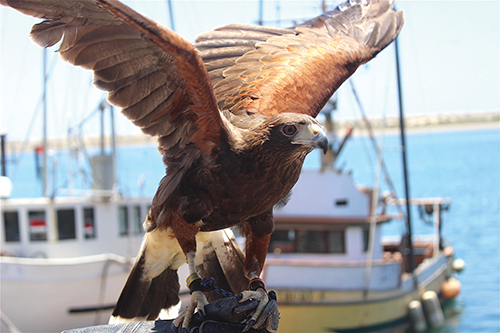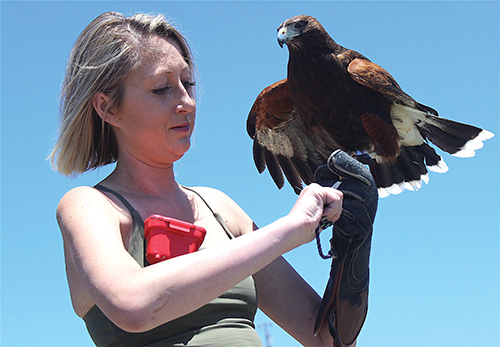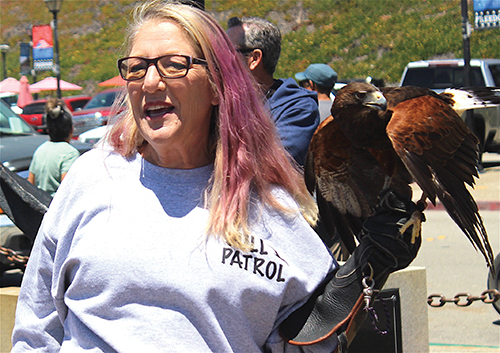An angry seagull swoops in to try and chase off Ranger, a Harris’ hawk owned by Airstrike Bird Control of Atascadero. That’s falconer Sammi Jackson holding the hawk.
What do you do about seagull problems in a town that’s a self-proclaimed “Bird Sanctuary?”
In Morro Bay they’ve enlisted the help of a winged super hero, one instinctively feared and whose mere presence sends the winged scoundrels into a tizzy.
In May the City of Morro Bay contracted for the services of Airstrike Bird Control, a company that specializes in the use of birds of prey to chase away gulls and other avian pests.
Anita Wolf of Airstrike is one of the handlers of “Ranger,” a Harris’ hawk trained for gull patrol.
According to Wikipedia, “The Harris’s hawk, formerly known as the bay-winged hawk, dusky hawk, and sometimes a wolf hawk, and known in Latin America as peuco, is a medium-large bird of prey that breeds from the Southwestern United States south to Chile, Central Argentina, and Brazil.”

Wolf explained that Harris’ hawks are the only birds of prey that hunt as a pack. Ranger is 5-years old and fully grown, she said, while standing in Anchor Memorial Park. With Ranger still stowed away out of sight in a large crate, the gulls are already squawking in alarm.
Airstrike has another Harris’ hawk, Max, Wolf said, who splits time on the Morro Bay Waterfront with Ranger.
Wolf said the hawk’s job isn’t to harm or capture gulls but to deter them from roosting and nesting on rooftops through what amounts to a learned response.
It’s like if there’s a mountain lion in your backyard, Wolf explained, and you make a loud noise that scares it away. “You won’t have that lion there the second day. Eventually it leaves. That’s how this works.”
She steps up to the big box sitting atop one of the park’s picnic tables and brings out Ranger, a beautiful, majestic and fierce looking bird.

Immediately, gulls step up their alarm calls and, more begin to appear out of nowhere. A dozen seagulls enter the immediate airspace. They are not happy birds, seeing this formidable predator.
As Sammi Jackson, Wolf’s daughter and the lead falconer on the Morro Bay job, frees him from the box, the gulls start dive-bombing, even though Jackson holds him perched on her leather-gloved hand. (It’s as if the gulls are saying, “Never mind the girl; get that bird!”)
Jackson said the hawk’s natural prey is small rodents, like squirrels, gophers, rabbits, and they had to teach him to “chase seagulls, but not catch them. It takes three months to train them.”
The response of the gulls is almost comical, as they swoop in trying to scare away Ranger, who frankly doesn’t seem very concerned. A mere flap of the raptor’s wings sends the gulls fleeing, only to soar back around and do it again.
The falconers have been on duty in Morro Bay since the Wednesday before the Memorial Day Weekend, starting with a bird issue the fire department was having at the Harbor Street Firehouse.

Hundreds of seagulls had made homes on the roof of Albertson’s Market/Rite Aid next door to the stationhouse, and were using the department’s training tower, too, which left a stinky mess in their facility.
“That first night,” Wolf said, “there were 500 gulls on Albertson’s roof. By the time we finished, maybe 25% came back.” The rest apparently got the message and flew off to more hospitable environs.
“Their poop is corrosive,” Wolf said. “It gets into ductworks; it could eventually collapse” a structure.
She added that part of their work involves climbing onto rooftops to remove nests. “We clear nests daily,” she said, “so long as there are no eggs in them. Once a nest has eggs, we don’t remove the nests. Our goal is to get them to move back into the natural environment, and out of the built environment.”
They also do gull eradication at Morro Bay High School, vineyards, and at landfills, where the birds carry trash, and potentially diseases, away from the garbage heaps.
Wolf said the gulls attack garbage trucks that aren’t covered. “Once I watched them dump the load and 60 seagulls came flying out of the truck.” Landfills are “really a perfect environment for them,” said Wolf.
She said Airstrike started 29 years ago in Atascadero. “We were one of the first companies to do bird abatement,” Wolf said. They helped write regulations for bird abatement and their first contract was with Cold Canyon Landfill.
Despite there being seemingly lots of natural areas nearby for the gulls — including Morro Rock and a 4-mile long Sandspit, plus state parklands — the gulls “Choose building tops because it’s closer to their food,” Wolf said.
Indeed, restaurants along the Embarcadero have fought a running battle with marauding gulls, which can be brazen in their raids on people eating at outdoor patios. They’ll steal food right off your plate if you turn your back or let your guard down.
The scavenging gulls also raid garbage cans and scatter trash all over the place.
The garbage problems got so bad that several years ago, the City removed all the individual garbage cans set out along the Morro Rock parking lot, in favor of secured dumpsters located by the public restrooms.
Jackson said one of their success stories on The Embarcadero was at Giovanni’s Seafood Market and Galley, where they not only chased away the gulls (and pigeons too) they also pressure washed the roof.
“That first night was insane,” Jackson recalled. “We removed a couple of hundred nests the first couple of days. And in one week, there was a 90% decrease in the population.”
Baby seagulls are not like other, completely helpless baby birds, in that within a short time they can run around the roof tops “peep-peep-peeping” at their parents begging for food.
Jackson said when the baby birds start running, they risk falling off the rooftops and can be injured.
So why not just shoot them? Jackson said seagulls are protected by the Migratory Bird Act, but “Migratory doesn’t mean they actually migrate.” Plus Morro Bay is a bird sanctuary by law and simply killing them likely would be met with a public uproar.
As most Morro Bay folks can probably attest, seagulls are deadeye shots and can squirt their excretions at anyone or anything that annoys them.
“We wear hats,” Jackson said, “because seagulls can aim their poop. They also have facial recognition capabilities,” which means they now recognize the falconers when they arrive on the Embarcadero. They know that Ranger’s appearance isn’t far behind.
“We started at the fire station and buzzing Albertson’s,” Wolf said, “then the other shopping center [with Family Dollar Store].”
On the Embarcadero they started at Tidelands Park, and drove them down the Embarcadero and eventually back to the wild.
“Ninety percent of this job is understanding gull behavior,” Jackson said. “You have to figure out the quickest and easiest way to get them to move.”
Regardless of the small swarm of angry gulls buzzing Ranger at the park, the gull patrols seem to be bringing the numbers down. “Last week,” Jackson said, “We had thousands of gulls surrounding us.”
Indeed, before Ranger made his appearance, which drew a crowd of people too, there was nary a gull in sight. That changed very quickly, once Ranger came out of his box.
There are other methods available to deter gulls but they don’t always work, as gulls are pretty smart for having, well, bird brains.
“Some of them have been habitually here for many years,” Jackson said. “The ones that have only been here a little time, you can push them out to the natural areas.” Hi-tech is evidently not a solution.
“They can knock drones out of the air,” Jackson said. “Plus the batteries run down. We do use drones to inspect the buildings.”
As for fake owls, Jackson said they don’t work either. “We found a fake owl’s head in a nest,” said Jackson. “The Libertine has the body but the head was in a nest. We took 10 nests off the Libertine’s roof.”
Public Works Director, Greg Kwolek, said they looked at several ideas to combat the seagull problem including, flashing lights, spike strips and a falconer, among others.
“You can’t just do this for two weeks and drop it,” Kwolek said. “It has to be continuously.”
So how much is all this costing? Kwolek said it would be $25,000 to $40,000 including about $2,000 for educational signage; money the City Council approved last February to discourage people from feeding the gulls. It could become a permanent item on the City’s annual budget.
Airstrike has some 70 falconers and does eradication work in California, Arizona, Washington State, New Mexico, Montana and Missouri.
To contact Airstrike Bird Control regarding a nuisance bird problem, call (805) 391-0444.




